These suggestions and solutions for technical problems are taken from service bulletins published by Mercedes-Benz. They have been selected and adapted for use in independent repair shops.
Infrared Remote Central Locking System
All Models beginning in 1996
On each of these systems, it is critical to let your dealer have accurate information about the specific vehicle in question, not only its model year but any other information you may gather. Parts must follow the correct parts number, or the remote locking system will not function properly.
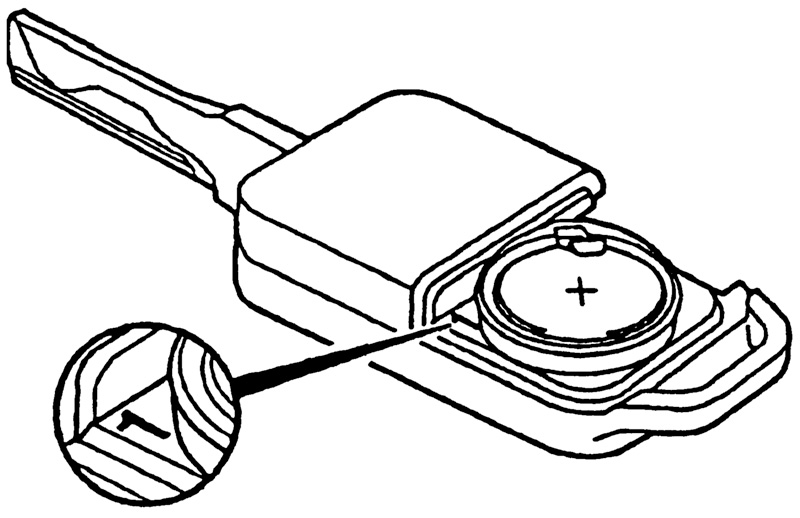 IR transmitters have an engraved numeral in the transmitter housing battery compartment. The transmitters that came with the car have numerals 1 and 2. Up to five additional IR transmitter ID’s are available for each vehicle, numbered 4 through 8.
IR transmitters have an engraved numeral in the transmitter housing battery compartment. The transmitters that came with the car have numerals 1 and 2. Up to five additional IR transmitter ID’s are available for each vehicle, numbered 4 through 8.
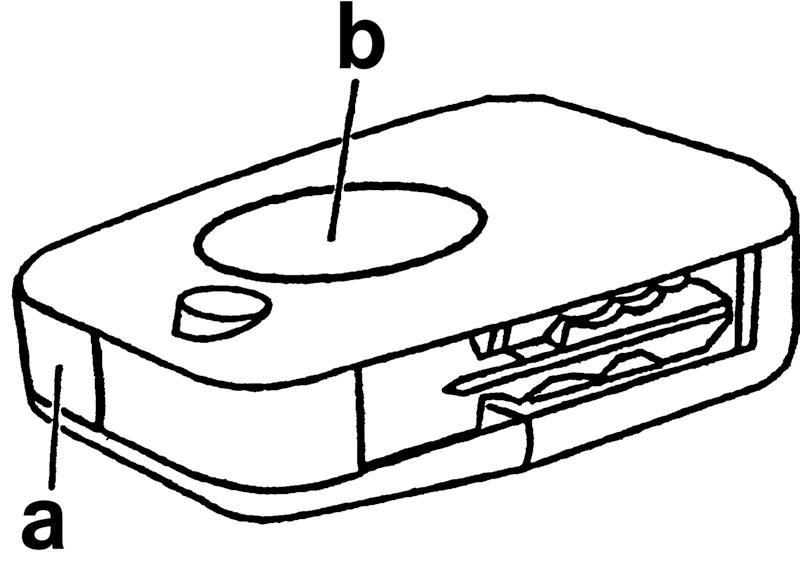 The remote locking system control module retains a memory for each individual transmitter used. This means that if a replacement transmitter had the same identification number as an existing one, the existing one would be automatically desynchronized from the control unit as soon as you synchronize the new one. Here’s how you synchronize a new one:
The remote locking system control module retains a memory for each individual transmitter used. This means that if a replacement transmitter had the same identification number as an existing one, the existing one would be automatically desynchronized from the control unit as soon as you synchronize the new one. Here’s how you synchronize a new one:
For 129’s and 140’s up to a build date of November 1993, point the transmitter window (a) toward an IR receiver and press the IR transmitter button (b). Then within 30 seconds, lock or unlock the vehicle using the mechanical key. Now the vehicle is synchronized to that transmitter.
For 129 and 140 from December 1993 to the beginning of 1995, point the IR transmitter window (a) at a receiver and press the button (b). Now within 30 seconds, switch on the ignition. Now that vehicle is synchronized to that transmitter.
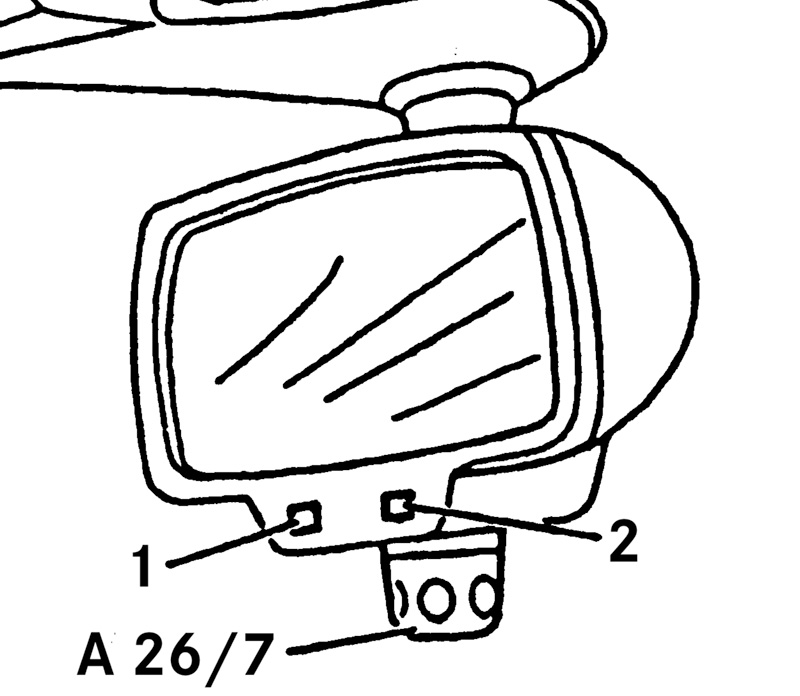 As of model year 1996 for all models, point the transmitter window (a) toward the receiver (A26/7) at the bottom of the interior rearview mirror. Press the button twice. Then using the mechanical key, switch the ignition on within 30 seconds. Now that vehicle and transmitter are synchronized.
As of model year 1996 for all models, point the transmitter window (a) toward the receiver (A26/7) at the bottom of the interior rearview mirror. Press the button twice. Then using the mechanical key, switch the ignition on within 30 seconds. Now that vehicle and transmitter are synchronized.
What can go wrong? Well, for one, the batteries in the transmitter may be dead or the contacts too resistant. Here’s how to check that: Press and hold the transmitter button (b) for more than one second. An LED in the transmitter window (a) should light to show the batteries are functional. If not, replace the battery or clean the contacts.
That’s not all, folks. You can also check to see whether the transmitter sends a signal using an IR Signal Indicator Card (like Radio Shack 276-0099). Follow the instructions that come with the card. The Mercedes-Benz Diagnostic Manual outlines the procedure to determine whether the vehicle then correctly reads the signal.
How can you determine the IR signal code? You can’t, of course! That’s the whole point of a central LOCKING system.
What if a transmitter is lost or stolen? Using the Mercedes-Benz Hand-Held Tester, you can irrevocably block a specific transmitter through the available menus. Do so only with the consent of the owner, obviously, and check all the transmitters he or she wants to retain, noting the numerals 1, 2 or 4 through 8 in those still on hand. Process of elimination tells you the numeral of the transmitter lost or stolen.
MBNA 80/22
Power Window Motor
Models 124 and 129
After the middle of July 1993, models 124 and 129 use the same power window motor, but when installing a replacement power window motor, be sure to use the three spacer sleeves and the related screws that come with the assembly. Left and right power window motors are mirror-image parts.
MBNA 72/12
Sliding/Pop-up Roof Drive Unit and Relay
Models 124, 126 and 201
The drive unit and a six-pole relay (the original was eight-pole) is available for these vehicles, and can serve as a retrofit in cars with the earlier version. The drives and relays of early and later versions are interchangeable, but once there has been substitution, the drive can only operate at one speed.
MBNA 77/16, 82/50
Fits-All Pneumatic Control
Model 140
After August 1994 there is only one pneumatic system control module, with an improved type of pneumatic connectors and distribution manifolds. The new module can retrofit to earlier vehicles, as usual with such improvements.
Here’s how to replace the module: Remove the rear seat cushion to expose it, and disconnect all the pneumatic lines from the multiple connector using a 7-mm (1/4-inch) open-end wrench. Snip off the old plastic connector from each line.
You’ll notice a lot of pneumatic lines, fortunately color-coded . The six yellow ones are for the central locking system; the two red ones are for backup assist; the one black line is for the retractable trunk lid grip; and the one clear (often faded to white) one is for manifold vacuum assist. Depending on the options built onto the car, there may also be three grey lines for the orthopedic seat backrest, and/or two white lines for the retractable rear head restraints.
First remove the old and install the new PSE control module.
 Then connect about 12 inches of pneumatic tubing to one of the sockets.
Then connect about 12 inches of pneumatic tubing to one of the sockets.
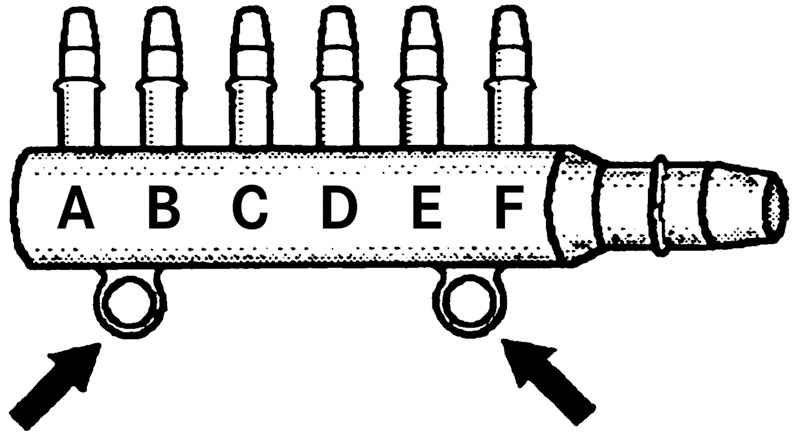 Attach the other end of the pneumatic line you just installed to the large end connector on a six-way manifold. Connect the six yellow central locking pneumatic tubes to the connections A to F on the six-way pneumatic manifold. Attach the socket and pneumatic line from the previous step to the connection on the PSE control module marked ZV.
Attach the other end of the pneumatic line you just installed to the large end connector on a six-way manifold. Connect the six yellow central locking pneumatic tubes to the connections A to F on the six-way pneumatic manifold. Attach the socket and pneumatic line from the previous step to the connection on the PSE control module marked ZV.
 Then slide the six-way pneumatic manifold over the two plastic split pins on the control module. Arrows indicate them on the line drawing above. Next connect the two red BA pneumatic lines to connections A and B on a two-way manifold. Attach the two way manifold to the connection on the pneumatic control module marked RH.
Then slide the six-way pneumatic manifold over the two plastic split pins on the control module. Arrows indicate them on the line drawing above. Next connect the two red BA pneumatic lines to connections A and B on a two-way manifold. Attach the two way manifold to the connection on the pneumatic control module marked RH.
Connect the black RTG pneumatic tube to a single socket and attach the socket to the pneumatic control module at connection P- or Pu.
If the vehicle does not have pneumatic rear headrests, put a rubber cap over the FKS connection on the pneumatic control module. If it does, connect the two white pneumatic lines to connections A and B on a two-way manifold and attach that to the FKS connection on the control module.
If the vehicle does not have OSB, put a cap over the connection marked Pu or P+ on the control module. If it does, connect a 12-inch section of pneumatic tubing to a socket and attach the other end of the tube to the large end connector on the six-way manifold as shown above. Connect the three grey OSB pneumatic lines to connections A to C on the six-way manifold and put rubber caps over connections D to F. Attach the socket and the pneumatic tube to connection Pu or P+ on the pneumatic control module.
Fasten the six-way manifold in place by sliding the two rings of the distributor over the plastic split pins on the control module.
MBNA 80/5
Glass Grief
Models 129, 140 and 210 after 1996
Various Mercedes-Benz models can exhibit unexpected problems if someone applies a metallic tint to the glass of the vehicle. Model 210 has the radio antenna in the backlite glass and most 129’s and 140’s have a rain sensor in the windshield glass that determines how fast to run the windshield wipers. A metallic tint can block radio reception for the one car and can interfere with the amount of light transmitted through the glass on the others. Stick with the glass the factory chose.
MBNA 67/04
Can’t Fill Tank?
If a motorist reports he or she can never get more than about three-quarters of a tank of fuel into his model 163, it’s more likely that the sending unit resistor card has the wrong calibration than that the fuel won’t go in. To see whether a particular vehicle falls into this category, check with your Mercedes-Benz dealer. T-SI-MBNA-47.20/05 includes all the vehicles affected and the relatively simple correction procedures.
MBNA 47.20/05
Electrical Connector Kit
All Models
If you do a lot of electrical work on Mercedes-Benz vehicles, you might find the factory electrical connector kit very useful. This includes not only vehicle-specific connectors, but also test connectors for various voltage, current and resistance measurements. All terminal ends and connectors are, of course, exactly mated to those on Mercedes-Benz vehicles.
MBNA 58.20/109
Handmade Trouble-Code?
All Models with ABS/ASR and/or Electronic Throttle
There are few things more frustrating than doing good work on a vehicle, only to find that somehow in the course of the work, you have set a trouble code that wasn’t there before you started. On most Mercedes-Benz cars with electronic throttle controls, the system expects to see throttle movement only in response to the accelerator pedal on the floor in front of the driver. If you take a short cut while working under the hood and open the throttle with the cable or linkage when the ignition is on, this can set a fault code for the electronic throttle or other component.
MBNA 30/3
Reduced IR Range after 1993
Models 129 and 140
After January 1993, the infrared key was modified to reduce the operational range of the convenience features (closing the windows and sunroof). Locking and unlocking range remains unaffected at about 19 feet, but the other features fall to about 10 feet. As they say in the computer business, ‘it’s not a bug; it’s a feature!’
MBNA 80/4
Overeager Park-Warning System
Model 140
If a motorist reports implausible park-warning operation, showing seven or eight bars on the indicator and sounding the acoustic warning when the vehicle is distant from any obstacles, this may be caused by vibration of the sensors in the bumpers, a kind of ‘tuning-fork’ resonance. A silicone ring to dampen this movement was introduced into production in 1996, and it can work for vehicles manufactured at other times. Remove the spacer ring, spring washer and nut. Replace them with the grooved spacer ring, the damper ring and the toothed nut.
MBNA 54.65/47
Installing Brake Controllers
Model 163
Few Mercedes-Benz cars tow trailers (and the company does not generally recommend it), but the model 163 sometimes does. While the manufacturer does not specifically recommend any brand of electric brake controller to actuate the electric brakes on a trailer, there is a recommended method for wiring the controller into the vehicle. Of course, your procedure should not only meet all the conditions of this procedure, but should be fully in accord with the instructions of the brake controller manufacturer, as well.
 Locate the three- to two-wire connector (N28) built into the wiring harness that comes with the trailer hitch kit (p/n Q6 31 0002). Cut the orange wire (A, circuit 1660) after N28 but before the place where the harness exits the vehicle through its grommet. Connect the end of the orange wire from N28 to a new wire (B) and run it to the brake controller. This wire provides the brake light signal to the controller, and need not be a heavy current carrier. Run a second wire (C) from the brake controller output connector to the end of the orange wire leading to the trailer electrical connector (X58). This is the electric brake line, and you should use wire of whatever gauge the brake controller manufacturer specifies or heavier. Follow the brake controller manufacturer’s instructions about connecting the power and ground circuits. Mercedes-Benz notes that most recommend using a circuit breaker and connecting the power and ground circuits directly at the battery. Perform all tests specified by the brake controller manufacturer and make certain the brake controller mounts within reach of the vehicle driver.
Locate the three- to two-wire connector (N28) built into the wiring harness that comes with the trailer hitch kit (p/n Q6 31 0002). Cut the orange wire (A, circuit 1660) after N28 but before the place where the harness exits the vehicle through its grommet. Connect the end of the orange wire from N28 to a new wire (B) and run it to the brake controller. This wire provides the brake light signal to the controller, and need not be a heavy current carrier. Run a second wire (C) from the brake controller output connector to the end of the orange wire leading to the trailer electrical connector (X58). This is the electric brake line, and you should use wire of whatever gauge the brake controller manufacturer specifies or heavier. Follow the brake controller manufacturer’s instructions about connecting the power and ground circuits. Mercedes-Benz notes that most recommend using a circuit breaker and connecting the power and ground circuits directly at the battery. Perform all tests specified by the brake controller manufacturer and make certain the brake controller mounts within reach of the vehicle driver.
MBUSA 31.19/03
Battery Damages Roof Seal?
 Model 215
Model 215
Yes, it can happen if the battery has been disconnected, perhaps for storage or shipping purposes. The roof seal extends over the side glass by about 4 mm as shown, so when the doors are opened or closed the glass can damage the seal.
SI 88.85/22
Limp-Home Transmission
Model 163
If the transfer case shift motor wiring sustains damage from coming into contact with the exhaust heat shield, this can trigger a transmission limp-home mode, in which the vehicle stays in the last selected gear, and the computer sets Diagnostic Trouble Code (DTC) P1831, flagging a transfer case position sensor or motor fault in the transfer case control module (N78). Check the transfer case shift motor wiring for damage.
If the wiring is severed, fold over the sheet metal at the point where it contacted the harness until there is at least 30-mm distance between them. Replace the transfer case shift motor. Erase the DTC using the Hand-Held Tester, and confirm the transfer case shifts properly.
If the wiring is not severed, bend the metal of the shield out of the way as described above, then remove the mounting bracket bolt to get access to the transfer case shift motor wiring. Repair the wiring with insulation damage using heat-shrink tubing. Reinstall everything where it belongs; erase the DTC and confirm proper operation of the transfer case shift motor.
MBNA 28.19/02
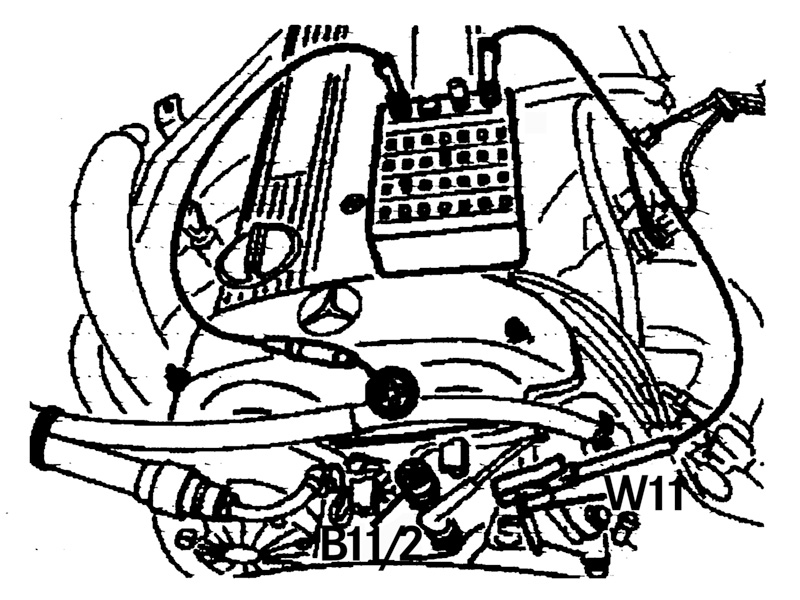 Checking Ignition Timing
Checking Ignition Timing
All Models with Distributors
Before you can check the ignition timing on any engine with conventional ignition and a distributor, the engine coolant must be between 75 and 90 degrees C. Since that is not always convenient to measure at the same time you’re doing other work, you can also substitute, as on the 102 engine in the illustration, a resistance of 320 ohms. Unplug the connector for the EZL coolant temperature sensor and put the specified resistance across the connector.
05.03.2002 CD-Ausgabe
Installing GPS Navigation
Model 163
While you could bolt one of those domes they put on tractor-trailers on someone’s 163, there are advantages to using factory equipment, even beyond the appearance. Here’s how to install the version from Mercedes-Benz. Note the map data CD does not come with the hardware kit. The geographically appropriate CD can be ordered from MBUSA; the VIN has to be identified so the company can send the second disk to the customer later. The system is warranted only in the vehicle in which it was originally installed. Moving it to another car voids the guarantee. Mercedes-Benz also cautions that the components should remain in the positions designated in the instructions. A further preparatory note: Dark window tinting may adversely affect GPS reception and the system’s function. Sometimes you have to choose between looking cool and knowing where you are.
There are specific installation instructions for most other models of Mercedes-Benz vehicles, which while functionally similar vary enough in detail that you should get them from your parts dealer before attempting the work. The carmaker also advises that on the 163, there must be a storage box under the passenger side seat, or else a new tray and storage box must be installed at additional cost. What’s more, if the customer wants a cellular phone in the vehicle, this is the cost-effective time to install it.
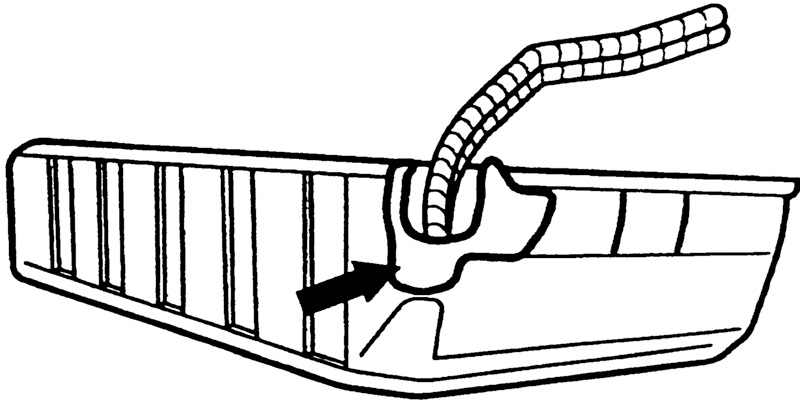 Use the navigation unit housing and its brackets as a template to mark the position for the two inner holes on each bracket. The back of the housing should be within an inch of the rear of the storage box, as shown. Drill 3.5-mm holes where you marked. Plug the 26-pin connector and grey GPS antenna connector into the back of the navigation unit, being careful not to kink either of the lines. Attach the navigation unit into the bracket from the bottom using the four M3 x 10 self-tapping screws in the kit
Use the navigation unit housing and its brackets as a template to mark the position for the two inner holes on each bracket. The back of the housing should be within an inch of the rear of the storage box, as shown. Drill 3.5-mm holes where you marked. Plug the 26-pin connector and grey GPS antenna connector into the back of the navigation unit, being careful not to kink either of the lines. Attach the navigation unit into the bracket from the bottom using the four M3 x 10 self-tapping screws in the kit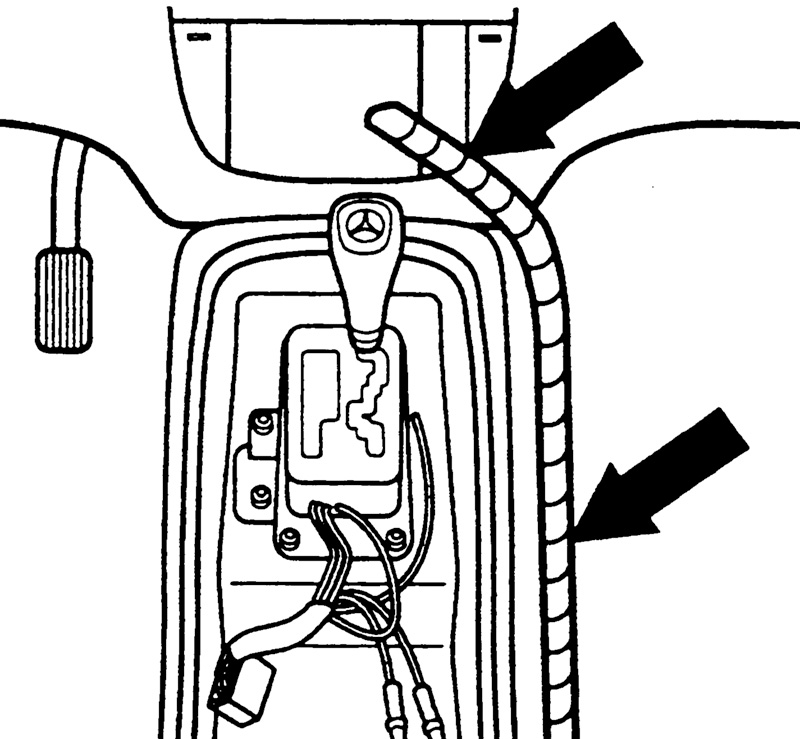
Cushion the back left corner of the storage box with felt to protect the harnesses from chafing against the metal edge. Since some 163 models are actually used off-road from time to time, this is an important step.
Run the harness along the right side of the console Leave the connector for the CAN-Bus adapter (the connector with the green and white wires) and the speaker connector in the center area of the console. Run the rest of the harness and the GPS antenna cable up the right side of the center console to the center of the dash.
The connector with red, pink and brown wires will connect near the radio, but run the GPS antenna cable (A in the diagram) and the display unit cable (B) up and out the air vent aperture.
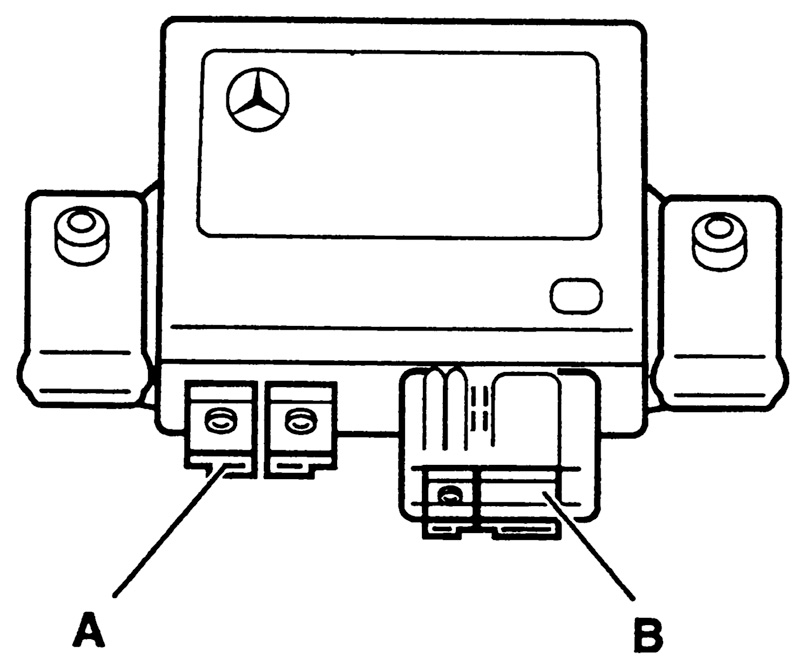 To install the CAN-Bus adapter, put the adapter with its bracket on the rear beam of the center console and mark the position of the two holes. The arrows show the direction of the front of the console. Drill 6.5-mm holes for the screws and secure the bracket and adapter with the screws in the kit. Attach the CAN-Bus adapter by driving the screws from the underside of the console into the bracket with the two M6 x 12 self-tapping screws.
To install the CAN-Bus adapter, put the adapter with its bracket on the rear beam of the center console and mark the position of the two holes. The arrows show the direction of the front of the console. Drill 6.5-mm holes for the screws and secure the bracket and adapter with the screws in the kit. Attach the CAN-Bus adapter by driving the screws from the underside of the console into the bracket with the two M6 x 12 self-tapping screws.
Plug the connector with the green and white wires into terminal A on the CAN-Bus adapter on the console. Notice the connector is keyed and will only fit into the left side of the two-port connector on the adapter. The other port is unused. Connect the black 18-pin connector to the CAN-Bus adapter at B. Plug the yellow connector into the speaker.
You’ll have to modify the center air vent slightly to make everything fit. File a notch between the second and third vent from the left for the display unit and GPS antenna cables, following the pattern in the illustration.
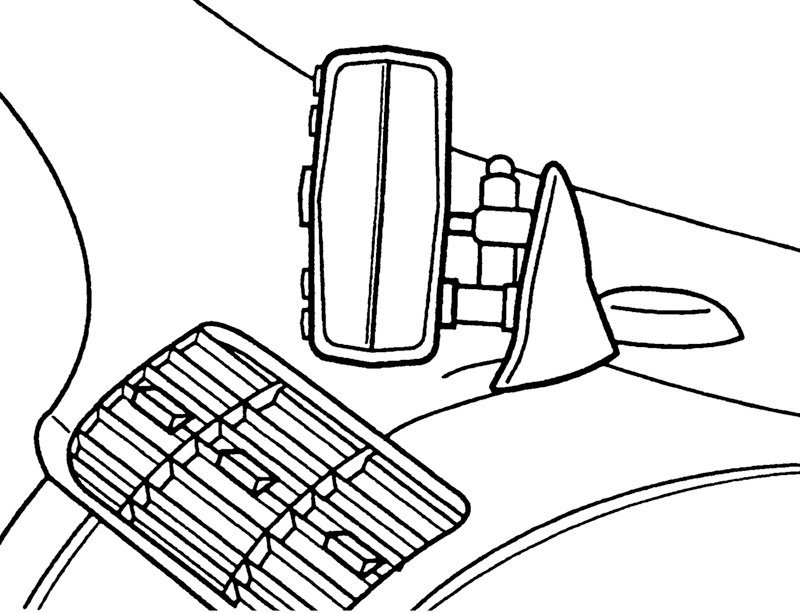 To allow mounting the bracket, file one mm from the front top edge of the middle vent. Put the bracket on the vent lining up the two notches and use the width of the front metal part of the bracket to correctly size the notch you file.
To allow mounting the bracket, file one mm from the front top edge of the middle vent. Put the bracket on the vent lining up the two notches and use the width of the front metal part of the bracket to correctly size the notch you file.
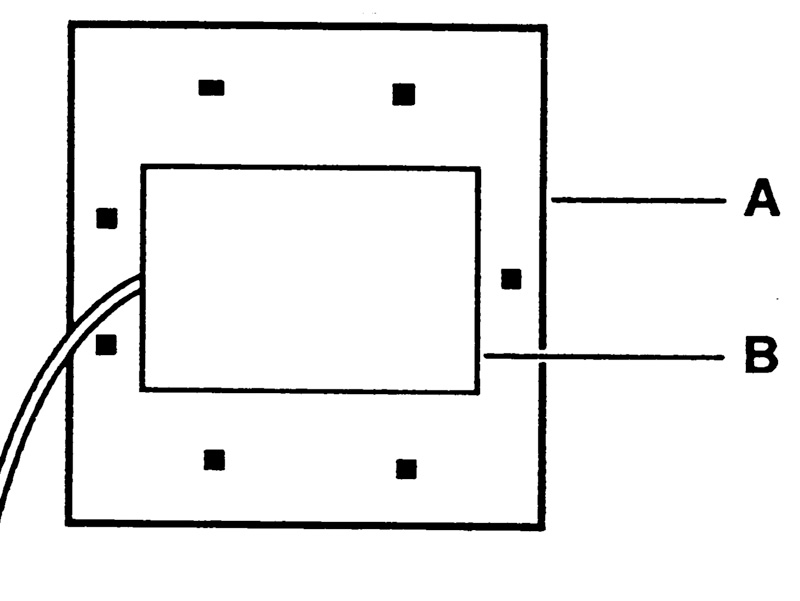 Mount the display unit to the bracket with the M6 x12 screws and washers in the kit. Put the lock washer between the screw head and the flat washer. Plug the round 13-pin connector into the back of the display unit. Peel the tape from the back of the ground plane. Stick the GPS ground plane on the dashboard directly behind the display unit bracket with the single dot facing the windshield.
Mount the display unit to the bracket with the M6 x12 screws and washers in the kit. Put the lock washer between the screw head and the flat washer. Plug the round 13-pin connector into the back of the display unit. Peel the tape from the back of the ground plane. Stick the GPS ground plane on the dashboard directly behind the display unit bracket with the single dot facing the windshield.
Put the GPS antenna on the ground plane, centered inside the dots. Be careful throughout this installation that you don’t kink the GPS antenna cable anywhere, or there will be diminished satellite position information reception.
The unit can ordinarily calibrate vehicle speed automatically, but if during your test drive, the vehicle icon on the screen moves erratically, check the vehicle sped pulse. If the number on the display does not appear correct, you’ll have to calibrate the vehicle pulse manually. In Diagnostics, select System Configuration and press enter. Select Calibrate Distance, and press enter. Highlight Start Calibration, when you’re ready, press enter and drive exactly one mile. Then press enter to end calibration.
Enter 5280 feet using the arrow button and press enter. As long as the distance percent is between –19.9 percent and 19.9 percent, the system can calibrate the distance. Press enter to accept the value and again to complete calibration.
Check that the system reads reverse. From the diagnostics menu, highlight Reverse and press enter. Shift the gear lever between reverse and neutral. The screen should reflect the gear accurately. Check the connection contact otherwise.
Confirm GPS satellite reception by parking in an area clear of large structures, wires and trees. Exit the diagnostic screen completely using the cancel button. At the caution screen press enter and then press the map button. When the GPS light at the bottom of the display turns green while the car is stationary, this confirms reception, but it can take as long as 15 minutes to confirm reception. GPS reception is impossible, of course, in tunnels, underground garages and other sorts of covered roadways.
Check the volume while you’re waiting for confirmation of reception. Press the option button, scroll down to voice, choose volume setting 3 and press enter. To check the system once everything up to this point is complete, enter a destination. Highlight points of interest, then press enter. Choose a destination and press enter. Recall the system will save the destination you’ve chosen in its memory. After the system calculates a route, there should be a voice prompt, “Please proceed to the highlighted route.†If you don’t hear the voice, check the volume in the option screen and the speaker connection.
If the installation worked correctly, the car should track accurately on the display. Often on the initial operation of the system, the car and GPS system may require several minutes of driving time at about 30 mph with good GPS reception to correct any positioning errors.
MBUSA 82.85/103A
 Loose Switches in Center Console
Loose Switches in Center Console
Models 124, 129, 140 and 202
This is an alternative procedure to replacing some of the wood parts, which may be very hard to color match since each comes from different trees.
If the plastic frame (2 in the illustration) has separated from the wooden cover (1) or the tabs have broken, get a new plastic frame (part numbers vary by model) first remove the gearshift lever cover.
 You can remove the old plastic frame (2 in the illustration) from the wood cover (1) by prying it off carefully with a screwdriver or other suitable tool. Keep in mind, it is the wood cover that is valuable, not the plastic!
You can remove the old plastic frame (2 in the illustration) from the wood cover (1) by prying it off carefully with a screwdriver or other suitable tool. Keep in mind, it is the wood cover that is valuable, not the plastic!
With a 2-mm drillbit, bore ten holes into the new plastic frame. The illustration shows where to drill the holes.
Using a 5-mm drillbit, hand countersink the holes in the plastic so the screws will be flush when finally mounted.
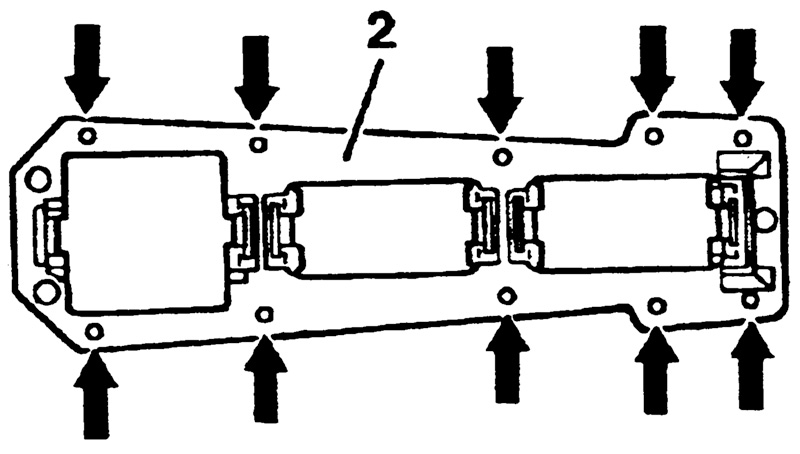 Put the plastic frame on the wood cover and align them exactly by installing the switches. With a 1.5-mm drillbit, drill holes for the screws in the wood cover, using the plastic frame as a template. It is critical to stop well short of drilling through the wood! Use a drill stop or depth gauge to insure you go no deeper than 3 mm or you could damage the wood cover. This is obviously not a step to rush.
Put the plastic frame on the wood cover and align them exactly by installing the switches. With a 1.5-mm drillbit, drill holes for the screws in the wood cover, using the plastic frame as a template. It is critical to stop well short of drilling through the wood! Use a drill stop or depth gauge to insure you go no deeper than 3 mm or you could damage the wood cover. This is obviously not a step to rush.
Fasten the plastic frame on the wood cover with special screws, available for the purpose from your Mercedes-Benz dealer as part number 124 990 00 30. Then reinstall the switches and the wood cover.
MBNA 68/5A
 Unlocking Options
Unlocking Options
Model 163
- Mechanical key release
- Lock
- Unlock
- Liftgate unlock
- Panic
The locking systems on Mercedes-Benz vehicles have become more sophisticated in the last decade or so, and sometimes car owners don’t know exactly how their vehicle system is supposed to work. On the model 163 the RF (radio frequency) key has these functions: Pressing the unlock button (3) once unlocks the driver’s door and the fuel filler cap only. This is sometimes called “selective unlocking.†Pressing the unlock button a second time shortly after the first unlocks all the other doors, the rear liftgate and the fuel filler flap. This is sometimes called “global unlocking.†This is the way the system is supposed to work; it does not require or allow repair to change these functions.
MBNA 80.35/10
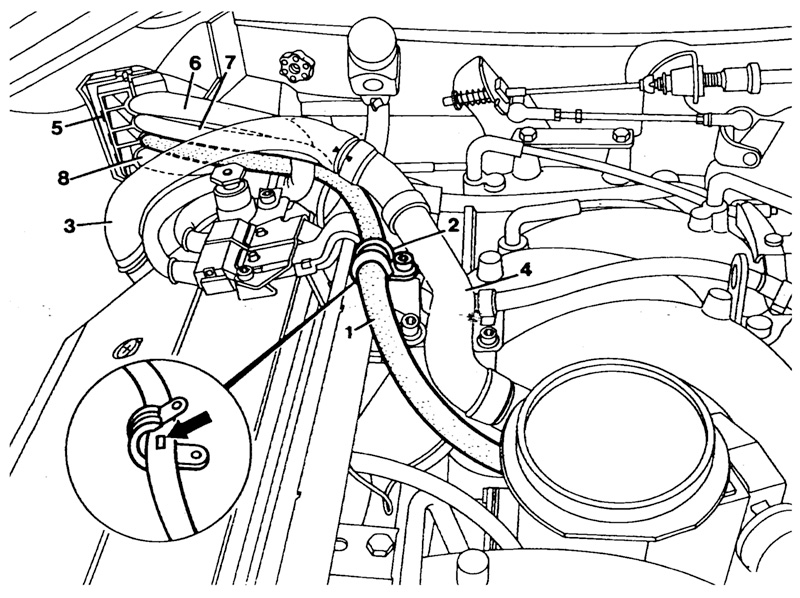 Proper Routing for EA/CC/ISC Harness Model 124
Proper Routing for EA/CC/ISC Harness Model 124
 When removing or installing an air cleaner, be certain the EA/CC/ISC actuator harness (1) is not damaged or misrouted. It must lie under the formed hoses for crankcase ventilation (3 and 4) and then through the hinged grommet (5).
When removing or installing an air cleaner, be certain the EA/CC/ISC actuator harness (1) is not damaged or misrouted. It must lie under the formed hoses for crankcase ventilation (3 and 4) and then through the hinged grommet (5).
For engine serial numbers up to 001910, however, replace the formed crankcase ventilation hoses (3 and 4) and route by the figure below.
- Electronic accelerator/cruise control/idle speed control actuator harness
- Hinged grommet
- Engine harness
- Starter motor harness
- Engine coolant return line from heater core
In each case, route electrical harnesses 1, 6 and 7) as well as the engine coolant return line for the heater core (8) through the corresponding holes (6, 7, 1 and 8) in the figure above. Reconnect the hinged grommet by pressing the parting surfaces together.
SI 30 11a
Â


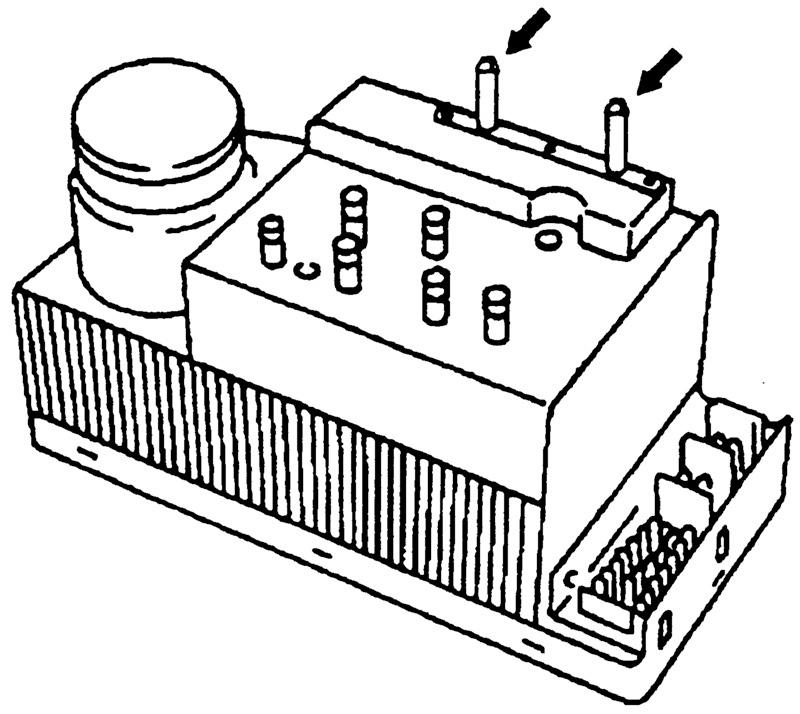
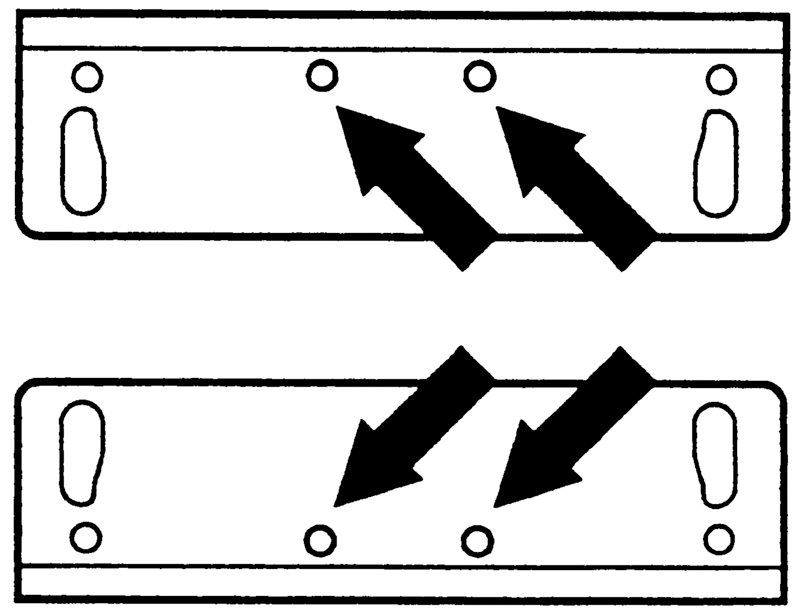
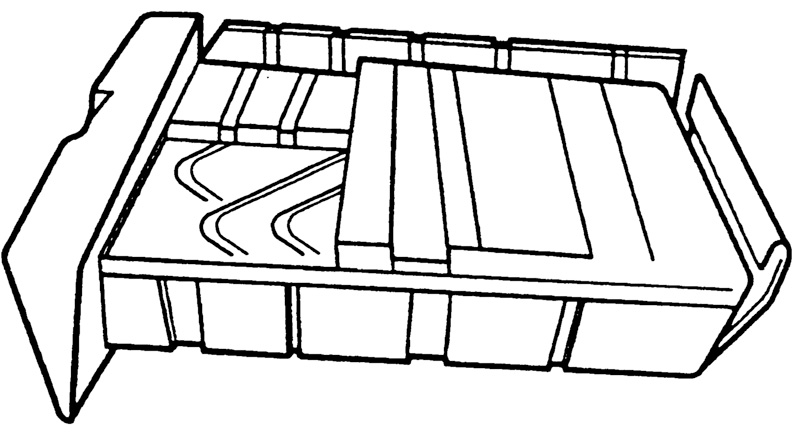



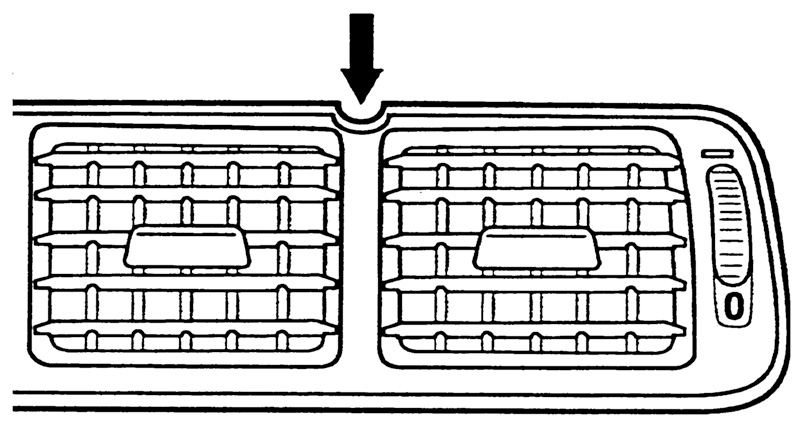
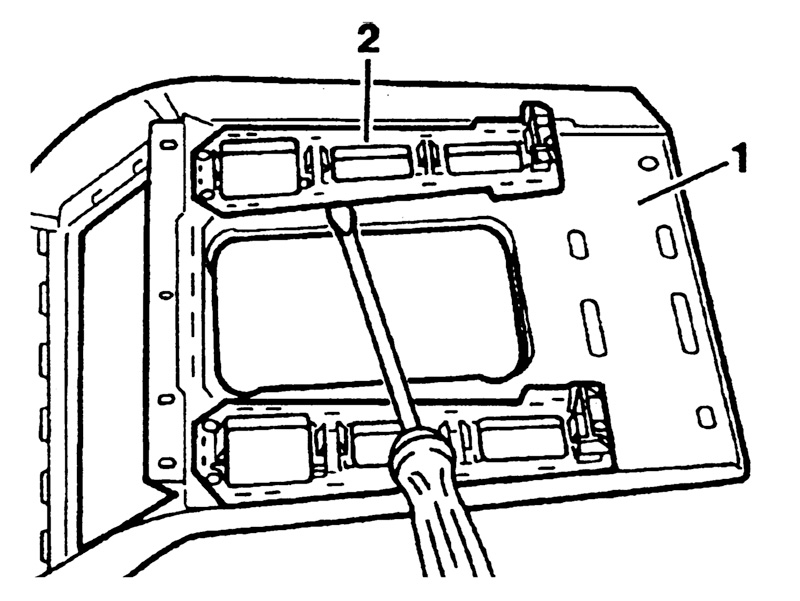
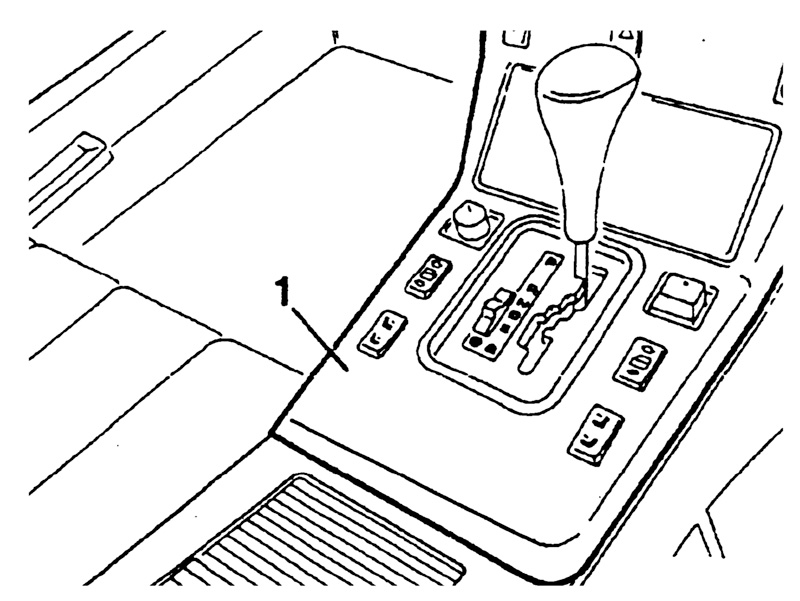
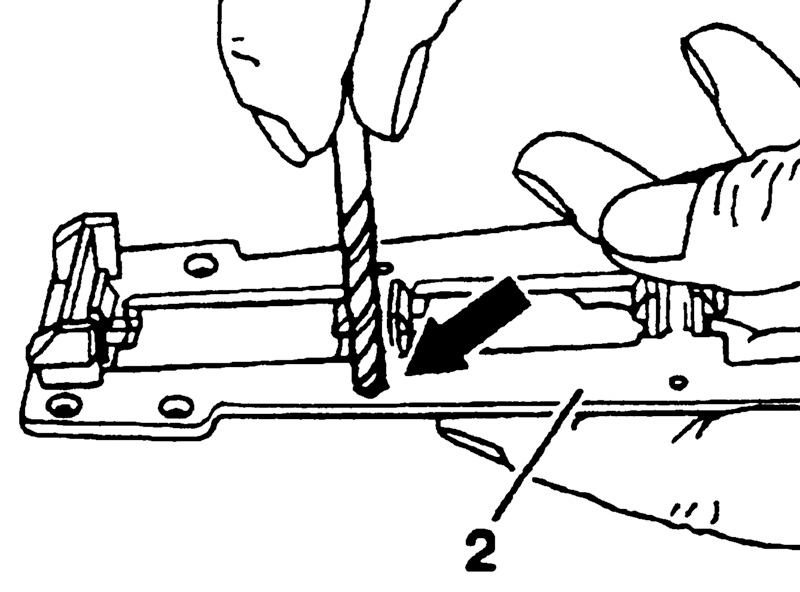
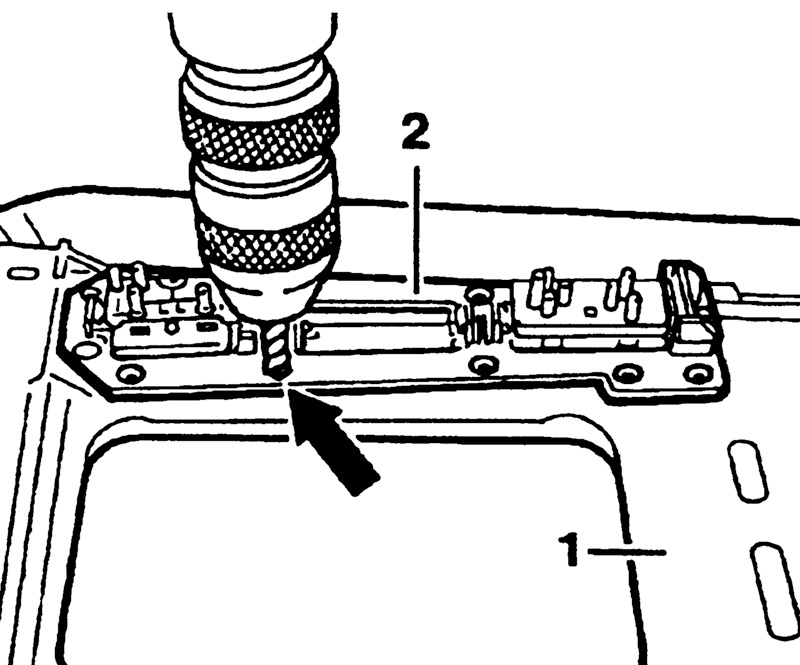




0 Comments